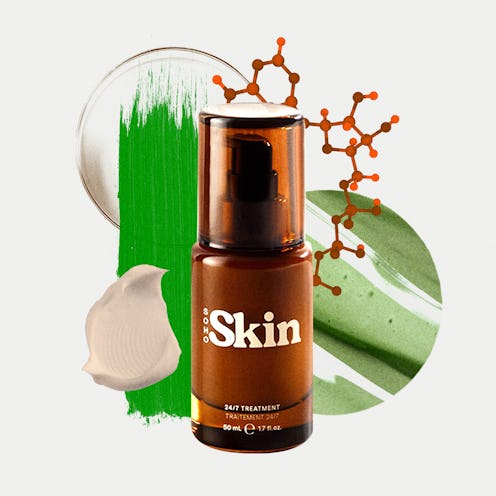(Back To Basics)
This Buzzy Skin Care Ingredient Is Like An Energy Drink For Your Face
Meet ATP.

With new products, brands, and categories popping up every day, beauty can be a bit overwhelming. Back to Basics is our rudimentary beauty series that serves as your crash course on the science behind some of the best formulations in the game. This week, we’re taking a look at adenosine triphosphate (ATP) for your skin.
Going to bed late or tossing and turning all night often leads to a tired morning. While a latte with an extra shot of espresso or a steaming hot shower can help wake you up enough to get through the day, when your skin is acting lethargic, adenosine triphosphate (ATP for short) can be called on to help reenergize it.
Currently, ATP is a skin care ingredient that’s generating buzz for its anti-aging and soothing benefits, but the body also naturally produces it as an organic compound and vital energy source for living cells. This includes boosting fibroblast function in the skin which can potentially stimulate collagen production. When ATP is applied topically in a skin care formula, it can also help boost collagen, strengthen, and calm skin.
As a newer ingredient, there are few studies on topical products with ATP related to skin function. However, adenosine, one of its structures, has been shown to improve the appearance of wrinkles and moisture levels in women between the ages of 30 and 50.
Sounds promising, right? Ahead, TZR turned to a dermatologist and a cosmetic chemist for a complete rundown on ATP in skin care, including the ingredient’s benefits, side effects, and how to incorporate it into your routine for optimal results.
What Is Adenosine Triphosphate (ATP)?
According to Dr. Geeta Yadav, board-certified dermatologist and founder of FACET Dermatology, adenosine triphosphate is “the primary source of energy for most biological processes in the human body.” The dermatologist notes that adenosine is also one of the four building blocks of ribonucleic acid (RNA). “Like deoxyribonucleic acid (DNA), RNA and its components, including adenosine, are critical to human life,” she says. In topical skin care, ATP is typically extracted from yeast.
Dr. Yadav points out the lack of studies on ATP’s role in topical skin care, but confirms that adenosine has been shown to be effective at improving the appearance of wrinkles and boosting collagen production. It’s all a bit scientific, so the easiest way to think of ATP is to think of it as an energy source — like plugging a lamp into an electric socket.
“Healthy and youthful appearance of skin requires optimal cellular metabolism in order to maintain connective tissue,” Krupa Koestline, clean cosmetic chemist and founder of KKT Consultants, explains. “The extracellular matrix that carries important proteins like collagen, elastin, etc is the result of a complex system of interactive anabolic processes. The maintenance of these requires energy. This is where ATP comes in.”
Who Should Use ATP & What Are The Potential Side Effects?
Ease of use is one big reason ATP is such an attractive ingredient. It’s virtually safe for all skin types and doesn’t have any known side effects.
That said, because ATP can help improve the look of fine lines and wrinkles, Dr. Yadav says those who are concerned about signs of aging would benefit the most from incorporating it into their skin care routines.
“Because this ingredient can help improve the appearance of fine lines and wrinkles, those who are concerned about signs of aging — even those who are interested in prevention — can benefit from using ATP or adenosine,” she confirms.
How To Use ATP In Your Skin Care Routine
While ATP is starting to pop up in toners and eye creams, you’ll mostly see the ingredient in serum formulations. Conveniently, this is how Dr. Yadav recommends adding ATP to your skin care routine. “I'd recommend using ATP in a serum format as serums are designed to deliver targeted treatment to the skin,” she says.
When deciphering between products, look for a formula that contains additional anti-aging ingredients for added benefits. “I'd look for a formula that contains hyaluronic acid, retinol, and/or vitamin C as these ingredients can all improve the appearance of wrinkles — hyaluronic acid by plumping up lines, retinol by stimulating cellular turnover, and vitamin C for triggering collagen production,” suggests Dr. Yadav.
Keep scrolling for a few ATP product suggestions to help get you started on incorporating the ingredient into your skin care regimen.
Shop ATP Skin Care Products
This article was originally published on